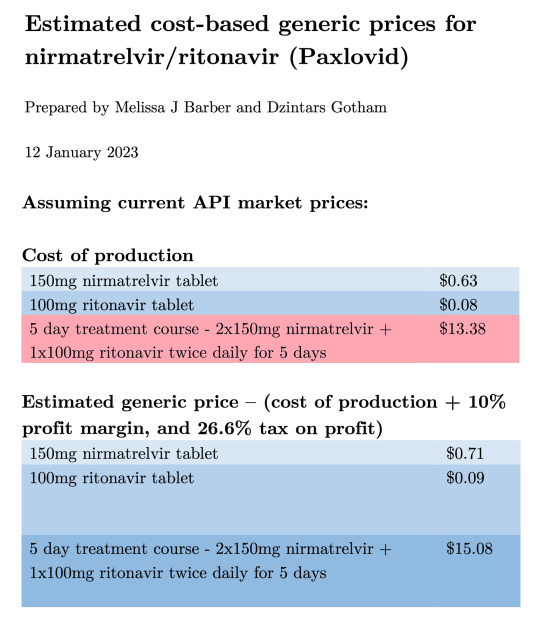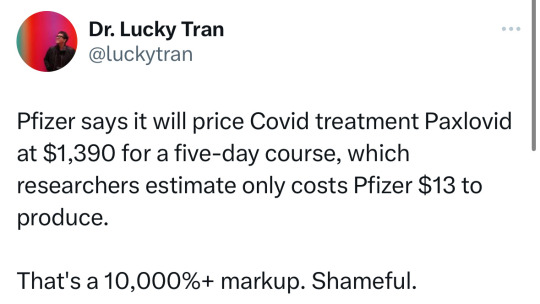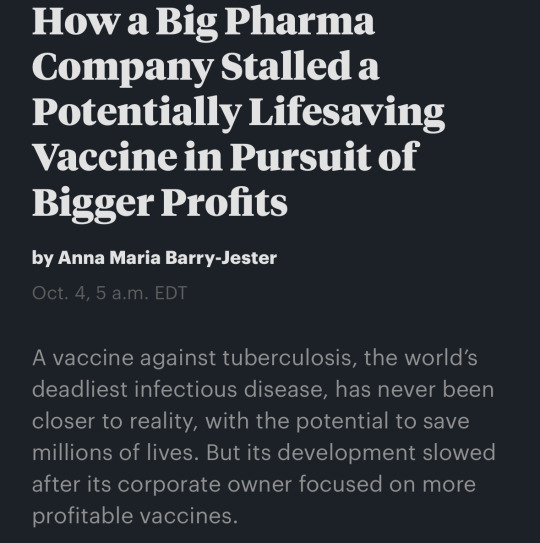#News pharma
Explore tagged Tumblr posts
Text
The Role of GMP Facilities in Europe's Pharmaceutical Growth
The production of medicines is crucial to the growth of Europe’s life science sector, driving demand for manufacturing space across the continent. While R&D is vital, delivering products to market requires adherence to Good Manufacturing Practice (GMP) guidelines. Key European Hubs Certain European regions, notably Ireland, Switzerland, the Netherlands, Belgium, and Germany, are becoming key…
View On WordPress
0 notes
Text
"The Biden Administration last week [early December, 2023] announced it would be seizing patents for drugs and drug manufacturing procedures developed using government money.
A draft of the new law, seen by Reuters, said that the government will consider various factors including whether a medical situation is leading to increased prices of the drug at any given time, or whether only a small section of Americans can afford it.
The new executive order is the first exercise in what is called “march-in-rights” which allows relevant government agencies to redistribute patents if they were generated under government funding. The NIH has long maintained march-in-rights, but previous directors have been unwilling to use them, fearing consequences.
“We’ll make it clear that when drug companies won’t sell taxpayer funded drugs at reasonable prices, we will be prepared to allow other companies to provide those drugs for less,” White House adviser Lael Brainard said on a press call.
But just how much taxpayer money is going toward funding drugs? A research paper from the Insitute for New Economic Thought showed that “NIH funding contributed to research associated with every new drug approved from 2010-2019, totaling $230 billion.”
The authors of the paper continue, writing “NIH funding also produced 22 thousand patents, which provided marketing exclusivity for 27 (8.6%) of the drugs approved [between] 2010-2019.”
How we do drug discovery and production in America has a number of fundamental flaws that have created problems in the health service industry.
It costs billions of dollars and sometimes as many as 5 to 10 years to bring a drug to market in the US, which means that only companies with massive financial muscle can do so with any regularity, and that smaller, more innovative companies can’t compete with these pharma giants.
This also means that if a company can’t recoup that loss, a single failed drug can result in massive disruptions to business. To protect themselves, pharmaceutical companies establish piles of patents on drugs and drug manufacturing procedures. Especially if the drug in question treats a rare or obscure disease, these patents essentially ensure the company has monoselective pricing regimes.
However, if a company can convince the NIH that a particular drug should be considered a public health priority, they can be almost entirely funded by the government, as the research paper showed.
Some market participants, in this case the famous billionaire investor Mark Cuban, have attempted to remedy the issue of drug costs in America by manufacturing generic versions of patented drugs sold for common diseases."
-via Good News Network, December 11, 2023
#united states#us politics#biden administration#executive order#prescription drugs#medical news#healthcare#healthcare access#biden#big pharma#drug prices#public health#nih#national institutes of health#good news#hope
10K notes
·
View notes
Text

Source


Source
11K notes
·
View notes
Text
A big cost and concern for many seniors in the U.S. is the price of prescription drugs and other healthcare expenses—and this year, thanks to The Inflation Reduction Act, their costs may go down dramatically, especially for patients fighting cancer or heart disease.
I learned about the new benefits because my ‘Medicare birthday’ is coming up in a couple months when I turn 65. I was shocked that there were so many positive changes being made, which I never heard about on the news.
Thousands of Americans on Medicare have been paying more than $14,000 a year for blood cancer drugs, more than $10,000 a year for ovarian cancer drugs, and more than $9,000 a year for breast cancer drugs, for instance.
That all changed beginning in 2023, after the Biden administration capped out-of-pocket prescriptions at $3,500—no matter what drugs were needed. And this year, in 2024, the cap for all Medicare out-of-pocket prescriptions went down to a maximum of $2,000.
“The American people won, and Big Pharma lost,” said President Biden in September 2022, after the legislation passed. “It’s going to be a godsend to many families.”
Another crucial medical necessity, the shingles vaccine, which many seniors skip because of the cost, is now free. Shingles is a painful rash with blisters, that can be followed by chronic pain, and other complications, for which there is no cure
In 2022, more than 2 million seniors paid between $100 and $200 for that vaccine, but starting last year, Medicare prescription drug plans dropped the cost for shots down to zero.
Another victory for consumers over Big Pharma affects anyone of any age who struggles with diabetes. The cost of life-saving insulin was capped at $35 a month [for people on Medicare].
Medicare is also lowering the costs of the premium for Part B—which covers outpatient visits to your doctors. 15 million Americans will save an average of $800 per year on health insurance costs, according to the US Department of Health and Human Services.
Last year, for the first time in history, Medicare began using the leverage power of its large patient pool to negotiate fair prices for drugs. Medicare is no longer accepting whatever drug prices that pharmaceutical companies demand.
Negotiations began on ten of the most widely used and expensive drugs.
Among the ten drugs selected for Medicare drug price negotiation were Eliquis, used by 3.7 million Americans and Jardiance and Xarelto, each used by over a million people. The ten drugs account for the highest total spending in Medicare Part D prescription plans...
How are all these cost-savings being paid for?
The government is able to pay for these benefits by making sure the biggest corporations in America are paying their fair share of federal taxes.
In 2020, for instance, dozens of American companies on the Fortune 500 list who made $40 billion in profit paid zero in federal taxes.
Starting in 2023, U.S. corporations are required to pay a minimum corporate tax of 15 percent. The Inflation Reduction Act created the CAMT, which imposed the 15% minimum tax on the adjusted financial statement income of any corporation with average income that exceeds $1 billion.
For years, Americans have decried the rising costs of health care—but in the last three years, there are plenty of positive developments.
-via Good News Network, February 25, 2024
#united states#medicare#healthcare#healthcare access#big pharma#prescription drugs#health insurance#us politics#good news#hope#seniors#aging#healthy aging
2K notes
·
View notes
Text
9 hours 9 persons 9 doors is possibly the funniest game on replay for many reasons but my underrated comedic bit of knowledge is the mystery of how the Kurashikis got all the money to run the second nonary game because at some point if you remember the door 4 santa dialogue you gotta just conclude "it was probably gambling right I mean if I had postcognitive esp I would absolutely cheat at gambling" but then on replay you look at that scene and the options youre presented with and the implication is actually like "dont be ridiculous. gambling is stupid. we OBVIOUSLY used the postcognitive esp to cheat at the STOCK MARKET what kind of idiot are you"
#no ethical consumption under capitalism says aoi kurashiki in his new tripp pants he bought with cradle pharma money#funny#999#999 spoilers#zero escape#ze spoilers#santa (ze)#june (ze)#aoi kurashiki#akane kurashiki#gghero rambles#meta#kurashiki siblings you will always be famous
234 notes
·
View notes
Text
History lesson about today's "Western medicine" aka toxins instead of natural holistic medicine.
Pharma companies sell synthetic chemicals as medicine 💉 🤔
#pay attention#educate yourselves#educate yourself#knowledge is power#reeducate yourself#reeducate yourselves#think about it#think for yourselves#think for yourself#do your homework#do some research#do your own research#ask yourself questions#question everything#rockefeller#big pharma#history lesson#history#hidden history#news
454 notes
·
View notes
Text

charmed + disarmed
#maccadam#MTMTE#TF Pharma#moving GIF#does this count as bot jewelry or lingerie?#they're supposed to be magnets with tassels#rhinestones and such#though that looks more like a flickering electric grid on his turbine than a sparkling net reflecting ambient light#which I suppose might be rather apt for the genre#but really the unsubtle effect is because I didn't want to put any more effort into this thing than I already have#even though this is just repurposing old art#...one of these days I'll draw something new#in the meantime I have a lot of writing to do
267 notes
·
View notes
Text

171 notes
·
View notes
Text

Finally, someone is exposing the lies about fluoride for all to see. It’s not longer just a Conspiracy Theorist rabbit hole. It’s another Conspiracy Realist exposition on how the government, big pharma, dentists, and nuclear waste facilities have been working together to sicken and kill Americans.
Us Conspiracy Realists have been right so much that maybe you should find one and make a friend. They’ll alert you to the next season of the Corporate Media Machine’s bullshit and tell you this shit coming downstream.
#truth#corporate media machine#rfk jr#deep state#globalism#new world order#dentists#big pharma#big pesticide#nuclear waste
99 notes
·
View notes
Text
Delphi Crossing

#transformers#maccadam#transformers fanart#transformers mtmte#ambulon#pharma#first aid#ratchet#animal crossing#animal crossing new horizons#crossover
56 notes
·
View notes
Text
The growing pharmaceutical production is poised to create a demand for European GMP facilities.
The rise in pharmaceutical production is driving increased requirements for European Good Manufacturing Practice (GMP) facilities due to several key factors: 1. Increased Demand for Medications The global pharmaceutical market is expanding due to several trends: Aging Population: Europe, in particular, has a growing elderly population that requires more medical treatments and…
View On WordPress
0 notes
Text
"The Biden administration on Thursday [August 15, 2024] released prices for the first 10 prescription drugs that were subject to landmark negotiations between drugmakers and Medicare, a milestone in a controversial process that aims to make costly medications more affordable for older Americans.
The government estimates that the new negotiated prices for the medications will lead to around $6 billion in net savings for the Medicare program in 2026 alone when they officially go into effect, or 22% net savings overall. That is based on the estimated savings the prices would have produced if they were in effect in 2023, senior administration officials told reporters Wednesday.
The Biden administration also expects the new prices to save Medicare enrollees $1.5 billion in out-of-pocket costs in 2026 alone.
“For so many people, being able to afford these drugs will mean the difference between debilitating illness and living full lives,” Chiquita Brooks-LaSure, administrator for the Centers for Medicare & Medicaid Services, told reporters. “These negotiated prices. They’re not just about costs. They are about helping to make sure that your father, your grandfather or you can live longer, healthier.”
It comes one day before the second anniversary of President Joe Biden’s signature Inflation Reduction Act, which gave Medicare the power to directly hash out drug prices with manufacturers for the first time in the federal program’s nearly 60-year history.
Here are the negotiated prices for a 30-day supply of the 10 drugs, along with their list prices based on 2023 prescription fills, according to a Biden administration fact sheet Thursday.
What Medicare and beneficiaries pay for a drug is often much less than the list price, which is what a wholesaler, distributor or other direct purchaser paid a manufacturer for a medication before any discounts...

The administration unveiled the first set of medications selected for the price talks in August 2023, kicking off a nearly yearlong negotiation period that ended at the beginning of the month.
The final prices give drugmakers, which fiercely oppose the policy, a glimpse of how much revenue they could expect to lose over the next few years. It also sets a precedent for the additional rounds of Medicare drug price negotiations, which will kick off in 2025 and beyond.
First 10 drugs subject to Medicare price negotiations
Eliquis, made by Bristol Myers Squibb, is used to prevent blood clotting to reduce the risk of stroke.
Jardiance, made by Boehringer Ingelheim and Eli Lilly, is used to lower blood sugar for people with Type 2 diabetes.
Xarelto, made by Johnson & Johnson, is used to prevent blood clotting, to reduce the risk of stroke.
Januvia, made by Merck, is used to lower blood sugar for people with Type 2 diabetes.
Farxiga, made by AstraZeneca, is used to treat Type 2 diabetes, heart failure and chronic kidney disease.
Entresto, made by Novartis, is used to treat certain types of heart failure.
Enbrel, made by Amgen, is used to treat autoimmune diseases such as rheumatoid arthritis.
Imbruvica, made by AbbVie and J&J, is used to treat different types of blood cancers.
Stelara, made by Janssen, is used to treat autoimmune diseases such as Crohn’s disease.
Fiasp and NovoLog, insulins made by Novo Nordisk.
In a statement Thursday, Biden called the new negotiated prices a “historic milestone” made possible because of the Inflation Reduction Act. He specifically touted Vice President Kamala Harris’ tiebreaking vote for the law in the Senate in 2022.
Harris, the Democratic presidential nominee, said in a statement that she was proud to cast that deciding vote, adding there is more work to be done to lower health-care costs for Americans.
“Today’s announcement will be lifechanging for so many of our loved ones across the nation, and we are not stopping here,” Harris said in a statement Thursday, noting that additional prescription drugs will be selected for future rounds of negotiations."
-via CNBC, August 15, 2024
#public health#healthcare#united states#us politics#biden#harris#kamala harris#medicare#medicaid#healthcare accessibility#prescription drugs#big pharma#insulin#good news#hope
3K notes
·
View notes
Text

Source
A better world is possible and it involves a publicly owned health care system
#health care#big pharma#news#current events#health#public health#the left#government#progressive#vaccines#capitalism
800 notes
·
View notes
Text

You know they're scared of the RFK nomination.
#trump#donald trump#trump 2024#democrats#covid#vaccine#anti vaxxers#medicare#healthcare#healthylifestyle#big pharma#pharmabusiness#covid vaccine#donald j. trump#president trump#rfk jr#nyc#new york#fox news#infowars#california#wef#cdc#biden#anthony fauci#fauci#fauci lied#socialist politics#united nations#masks
100 notes
·
View notes
Text

my face when im looking at 5783945 exact same pharma heads in my sketchbook idk
#bought new pen and tried to make lineart with only it!! love it#gotta practice a lot with it thoooo but it was fun#pharma#transformers#transformers idw#my art#traditional art#ink#cool beautiful chromatographic malevich ink so i dont even have to tryhard to make the pic look decent#ink does all the job itself
57 notes
·
View notes
Text

mystery solved
I spent ALL DAY getting mad abt pharmas dumbass guns when it was so simple all along..
I’m still mad abt it tho bc?? the arms connected to his guns would have to be so long for them to be moving around like they are in the two(?) whole panels they are in. It makes no sense
#my art#sorta???#my illegible ramblings#I’d like to know tho why/when he got these guns because it didn’t seem like ratchet knew about them so I’d think they’re either new-ish#Or something that just never came up ig??#maybe I’ll discover more as I continue to reread but I don’t remember anything else abt his guns#why am I so interested in pharmas guns? that remains to be seen#I’d love to see more things with his guns tho. cool character details make me happy#anyways actual drawings coming soon im practicing drawing this freak#pharma#tf pharma#transformers pharma#maccadam#transformers#ok time to go to sleep
67 notes
·
View notes